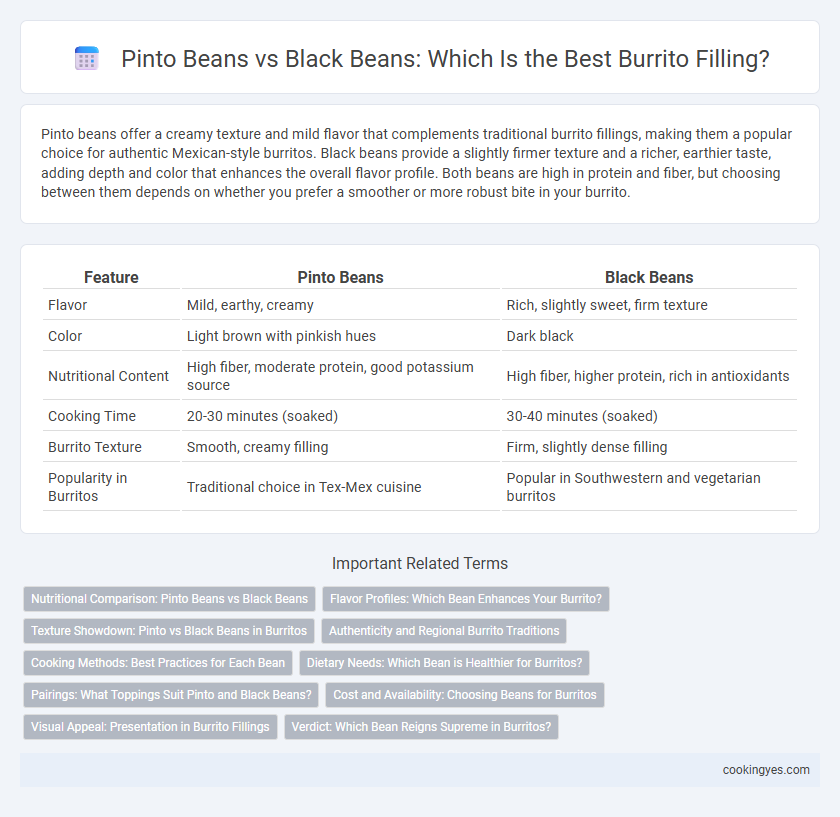Pinto beans offer a creamy texture and mild flavor that complements traditional burrito fillings, making them a popular choice for authentic Mexican-style burritos. Black beans provide a slightly firmer texture and a richer, earthier taste, adding depth and color that enhances the overall flavor profile. Both beans are high in protein and fiber, but choosing between them depends on whether you prefer a smoother or more robust bite in your burrito.
Table of Comparison
| Feature | Pinto Beans | Black Beans |
|---|---|---|
| Flavor | Mild, earthy, creamy | Rich, slightly sweet, firm texture |
| Color | Light brown with pinkish hues | Dark black |
| Nutritional Content | High fiber, moderate protein, good potassium source | High fiber, higher protein, rich in antioxidants |
| Cooking Time | 20-30 minutes (soaked) | 30-40 minutes (soaked) |
| Burrito Texture | Smooth, creamy filling | Firm, slightly dense filling |
| Popularity in Burritos | Traditional choice in Tex-Mex cuisine | Popular in Southwestern and vegetarian burritos |
Nutritional Comparison: Pinto Beans vs Black Beans
Pinto beans and black beans both offer high protein and fiber content, essential for a filling burrito. Black beans contain slightly more antioxidants and iron, while pinto beans provide more potassium and folate. Choosing between them depends on specific nutritional goals, with black beans supporting heart health and pinto beans aiding in muscle function and cellular growth.
Flavor Profiles: Which Bean Enhances Your Burrito?
Pinto beans offer a creamy texture and a slightly earthy, mild flavor that complements classic burrito ingredients without overpowering them. Black beans have a denser texture and a richer, slightly sweet and smoky taste that adds depth and boldness to the filling. Choosing between pinto and black beans depends on whether you prefer a subtle, traditional taste or a robust, flavorful burrito experience.
Texture Showdown: Pinto vs Black Beans in Burritos
Pinto beans offer a creamy, soft texture that blends seamlessly into burrito fillings, providing a smooth and hearty bite. Black beans maintain a firmer, slightly meaty texture that adds a contrasting bite and holds up well against other ingredients. Choosing between pinto and black beans depends on whether you prefer a velvety melt-in-your-mouth sensation or a more robust, chewy experience in your burrito.
Authenticity and Regional Burrito Traditions
Pinto beans are traditionally favored in Northern Mexican burrito recipes, emphasizing their creamy texture and mild flavor that complements authentic regional fillings. Black beans, commonly used in Southern Mexican and Southwestern U.S. burritos, offer a slightly sweeter taste and firmer consistency, aligning with those regional culinary traditions. Choosing between pinto and black beans reflects the cultural heritage of the burrito and enhances its authenticity depending on the desired regional style.
Cooking Methods: Best Practices for Each Bean
Pinto beans benefit from slow simmering to achieve a creamy texture, often enhanced by seasoning with cumin and garlic during cooking for authentic burrito flavor. Black beans require soaking overnight to reduce cooking time and maintain their firm, meaty consistency, making them ideal for burritos that need a robust bite. Both beans perform best when cooked low and slow, but black beans retain shape better in stews, while pinto beans blend seamlessly for smooth refried bean fillings.
Dietary Needs: Which Bean is Healthier for Burritos?
Pinto beans and black beans both offer high protein and fiber content, essential for a nutritious burrito filling, but black beans provide slightly more antioxidants and iron, supporting better heart health and immune function. Pinto beans are rich in folate and potassium, beneficial for muscle function and cardiovascular health, making them an excellent choice for balanced dietary needs. Choosing between the two depends on specific nutritional goals, with black beans favored for antioxidant intake and pinto beans for folate and potassium levels.
Pairings: What Toppings Suit Pinto and Black Beans?
Pinto beans complement classic burrito toppings such as shredded cheese, sour cream, salsa roja, and guacamole, enhancing their creamy texture and earthy flavor. Black beans pair well with fresh ingredients like pico de gallo, cilantro, diced onions, and lime juice, which accentuate their slightly sweet and dense profile. Both types of beans work well with jalapenos, lettuce, and Mexican rice for a balanced, flavorful burrito filling.
Cost and Availability: Choosing Beans for Burritos
Pinto beans are generally more affordable and widely available in most grocery stores, making them a cost-effective choice for burrito fillings. Black beans tend to be slightly more expensive and might not be as readily stocked in every region, especially in bulk quantities. For budget-conscious burrito preparation, pinto beans offer both economic advantage and easier access, while black beans provide a flavorful alternative when available.
Visual Appeal: Presentation in Burrito Fillings
Pinto beans provide a warm, earthy tone that enhances the rustic look of burrito fillings, while black beans offer a striking contrast with their deep, glossy color, making the filling visually pop against lighter ingredients like rice and salsa. The choice between pinto and black beans affects the burrito's overall aesthetic, with pinto beans blending softly and black beans creating sharper visual definition. Color balance plays a crucial role in presentation, as vibrant, varied hues attract more attention and increase appetite appeal in burrito dishes.
Verdict: Which Bean Reigns Supreme in Burritos?
Pinto beans offer a creamy texture and mild flavor that blends seamlessly with traditional burrito spices, making them a popular choice in Tex-Mex cuisine. Black beans provide a slightly firmer bite and a richer, earthier taste that enhances the overall depth of a burrito's flavor profile. For a balanced and authentic burrito experience, pinto beans reign supreme due to their versatility and harmonious integration with classic fillings like rice, cheese, and salsa.
Pinto beans vs black beans for burrito filling Infographic

 cookingyes.com
cookingyes.com